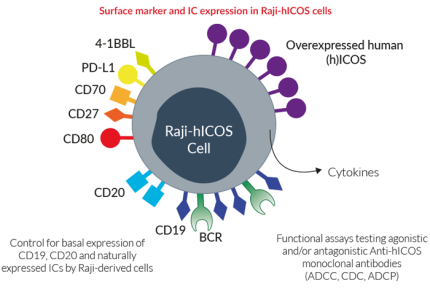Raji-hICOS Cells
-
Cat.code:
raji-hicos
- Documents
ABOUT
Human ICOS-expressing B cells
Raji-hICOS cells were developed from the human Raji cell line, a human B lymphocyte-derived cell line, and engineered to stably overexpress the human ICOS gene. Raji cells have been successfully used as target cells in human effector studies such as antibody-dependent cellular cytotoxicity (ADCC), either with peripheral blood mononuclear cells, natural killer (NK) cells, or T cell-derived Jurkat reporter cells.
Inducible Co-stimulator (ICOS, CD278) is a co-stimulatory immune checkpoint (IC) and a member of the CD28 superfamily. Expression of ICOS is rapidly induced in CD4+ and CD8+ T cells upon their activation, whereas its ligand ICOSL (also known as CD275), is mostly expressed on antigen-presenting cells [1]. The interaction between ICOS and ICOSL delivers a secondary co-stimulatory signal through the activation of the transcription factor AKT, which promotes T cell proliferation and differentiation as well as the production of cytokines [1]. In tumor immunity, ICOS is involved in the amplification of the anti-tumor cytotoxic CD8+ T cell response, as well as the 'pro-tumor' function and maintenance of regulatory T cells (Tregs). Therefore, both agonistic and antagonistic monoclonal antibodies (mAbs) targeting this pathway are being investigated in combinational cancer immunotherapy [2]. Notably, ICOS agonistic mAbs have been shown to potentiate the effects of anti-CTLA-4 mAbs [3].
Features of Raji-hICOS cells:
- Stable overexpression of the human ICOS gene
- Characterized by a number of cell-surface expressed markers including the B cell receptor (BCR), CD19, and CD20
- Constitutive expression of various immune checkpoints (ICs) such as CD27, CD70, CD80, PD-L1, and 4-1BBL
Applications for Raji-hICOS cells:
- Target cell line for ADCC assays using InvivoGen's Jurkat-Lucia™ NFAT-CD16 cells
- Target cell line for cell toxicity assays using NK or CAR-T cells
- For use in the development of novel human ICOS agonistic and antagonistic mAbs
Validation of Raji-hICOS cells:
- Overexpression of ICOS verified by flow cytometry
- Functionally tested as target cells in ADCC assays using anti-human ICOS mAbs and Jurkat-Lucia™ NFAT-CD16 cells
- Guaranteed mycoplasma-free
References:
1. Amatore, F. et al. 2020. Role of ICOS in cancer immunotherapy. Expert Opin Biol Ther 20, 141-150.
2. Solinas, C. et al. 2020. The rationale behind targeting the ICOS-ICOS ligand costimulatory pathway in cancer immunotherapy. ESMO Open 5.
3. Soldevilla, M.M. et al. 2019. ICOS Costimulation at the Tumor Site in Combination with CTLA-4 Blockade Therapy Elicits Strong Tumor Immunity. Mol Ther 27, 1878-1891.
Disclaimer: These cells are for internal research use only and are covered by a Limited Use License (See Terms and Conditions). Additional rights may be available.
SPECIFICATIONS
Specifications
ADCC assays using InvivoGen's Jurkat-Lucia™ NFAT-CD16 cells,
Complete IMDM (see TDS)
Validated using PlasmotestTM.
Each lot is functionally tested and validated.
CONTENTS
Contents
-
Product:Raji-hICOS Cells
-
Cat code:raji-hicos
-
Quantity:3-7 x 10^6 cells
- 1 ml of Blasticidin (10 mg/ml)
- 1 ml of Normocin™ (50 mg/ml)
Shipping & Storage
- Shipping method: Dry ice
- Liquid nitrogen vapor
Storage:
DOCUMENTS
Documents
Technical Data Sheet
Validation Data Sheet
Safety Data Sheet
Certificate of analysis
Need a CoA ?





